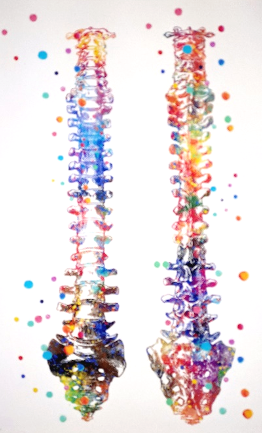Our Spine: A Column of Resilience and Endurance – by Chris Clayton
This topic resonates personally for me. My late father incurred a very serious spinal injury in the 1970’s, and I grew up seeing the effects of extreme spinal pain and inhibited movement. It’s possible that experience has played a key role in the development of my empathy and interest in hands-on therapy?
I have also had my own experience first-hand with a spinal injury that was not identified until I had an x-ray several years later, that showed a previous stable vertebral fracture from a long fall in the 1990’s, which then explained much of my chronic pain. The x-ray also showed that I had healed at the site of the injury, for which I am immensely grateful. But there was much more that needed to be done to get out of my chronic pain pattern.

“Movement is life. Life is a process. Improve the quality of the process and you improve the quality of life itself.” – Moshe Feldenkrais
One of the things that excited me about studying with Anatomy Trains was the module focused on the spine. The first module that most people do within the Anatomy Trains pathway is the foundational Anatomy Trains Structure and Function course, followed by the Part One series of modules. The fourth workshop in the Part One series is Tensegrity Spine. Tensegrity Spine is one of the modules that, as mentioned, I have a personal experience with.
In the Tensegrity Spine module, we look at the bony structures from coccyx to cranium, then overlay the myo-fascia and fascial layers to look at the spine as a tensegral whole. We do this so we can form our strategy to help this wonderful structure be as resilient and effective as it can be.
As an ATSI clinician I use this information literally daily when working with my clients. It constantly amazes me how much pain dysfunction, compression, and immobility of this system/structure can cause.
As individuals and therapists, we should never underestimate the painful effect of compensatory patterns involving soft tissue and their impact on our overall spinal health. I am sure that most of us can recall so many examples of clients that have had a scan (of which there are many types) and received a result indicating no structural issue with their spine, or nothing of great note. Yet, they still may be enduring lower back pain, or pain somewhere along the spinal column.
This is where Structural Integration and hands on body work can be of great assistance. In clinic we are looking to observe whether the lower structures such as the feet, legs, or pelvis are supporting the spine and where they could be in better balance, both in their static posture and in functional movement patterns. If every component of this orchestra can play its part, then ultimately the spine will need less compensatory patterns to get us through the day. Our aim is to help our clients move out of compensation and into adaptability and resilience.
We also need to look at what is above and along the spine (including the thoracolumbar layers of fascia) that might contribute to a client’s situation. We have multiple layers of spinal muscle and fascia that envelop and surround the vertebral bodies. We also need to take into consideration the discs, plus all of the smaller transversospinali group and deeper segmental muscle, when formulating our strategies. Then we work to ensure that the outer structures and their myofascial units can communicate to and from the spine and that load is distributed as far and wide and as evenly as possible. We are aiming to bring the whole system into a balanced tensegral relationship within the resources available to each client.
This possibly all sounds a little complex, but the tensegrity spine workshop provides us with a roadmap that helps us form a sound strategy so that we can work towards bringing ease and adaptability to our client’s spine and to integrate their spine with the greater whole of their body’s system.
It gives me a lot of satisfaction that I can help people that are in situations like my late father was, and the many other versions of back pain where soft tissue is involved in their chronic pain patterns.
Writing this blog also reminds me of the benefits of being able to receive informed Structural Integration work. It was not until I received my first twelve series of Structural Integration that I started to feel positive lasting change in the region of that old injury, plus it was change that I could keep!
Chris Clayton
